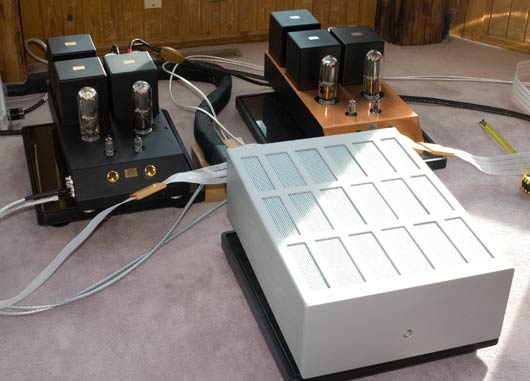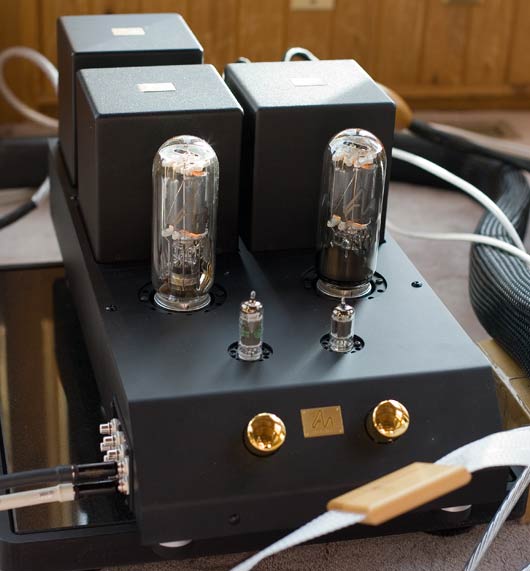Audio Note Jinro 211-based tube integrated amplifier
I’ve wanted to put the Jinro through its paces for a loooong time, ever since the Jinro integrated amplifier came to this country at last year’s CES, where I was impressed with its sound and its low cost. Like the bigger Ongaku, combining a very high quality stereo amplifier with a very high quality preamp in one chassis saves on power cords, interconnects, and amps stands/rack space. This allows one to achieve price-performance ratios unheard of in here in our Extreme High-end part of the audiophile hobby. Essentially, it allows you to get close to the Extreme high end at ‘slumming it’ prices.

We performed a shootout between the $20K Audio Note U.K. Jinro, in black, and the $95K Audio Note U.K. Ongaku, in copper. As you can see, they are very similar externally, and are using the same brand of 211 tubes. Internally the Jinro is wired with copper and uses copper-wound transformers as opposed all silver inside the Ongaku. They both weigh about 60 pounds or so and put out about 25 watts. Kevin O., Neli and I were in attendance.
The system was the Marten Coltrane Supreme speakers, Emm Labs digital, Nordost Odin interconnects and power cords, Jorma Design Prime speaker cable and HRS platforms. We will also do another, similar shootout on the All Audio Note system downstairs with Steve G., Neli and I doing the finger pointing at that time.

We played the Jinro first using our 3 test cuts: Gloria Esteban, Elton John and a short but complex Mozart piece.
It was great: good details, lots of good separation, dynamic, good color. The Elton was not quite as magical as we remembered it, but maybe we had exaggerated the magicality in our minds over the last few weeks. Certainly did not hear anything that didn’t sound great.

We then played the 3 cuts on the Ongaku. Kevin kept bringing up Mike Tyson, so I will put it like he did: It was like me, Mike Davis, and Mike Tyson going into the boxing ring. It wouldn’t take anybody very long to figure out who was the winner [me being the first, in that scenario :-)].
The Ongaku has a LOT more stuff happening between the notes, which allowed it to have a lot more resolution and the harmonics to be much more vivid. We went through the motions and played all 3 cuts – the Elton piece was as amazing and drug-like as we had remembered it being [more so in fact – hearing a song be ‘great’, and then soon after be ‘OMFG great’ has its own special kind of drug-like effect. More later on this].
As a shootout this was somewhat worthless – but we did learn a few valuable things nonetheless.

The $20K Jinro did a great job on this 1/2 million dollar system. Without hearing the Ongaku, many people would never know what they would be missing and would be very happy campers.

Is the Jinro as magical and drug-like as the Ongaku? No. But that is not saying much, as only very, very few other amps are.
But the system around a Jinro can be designed so that the Jinro doesn’t have to do ALL the heavy lifting [our test system is pure straight-line high resolution components and cables counting on the Ongaku do all the drug-like magic]. For such a Jinro-centric drug-like system, the Jinro will be able to supply very high-quality dynamics, separation, phenomenal note control, and harmonic purity…. and quite a lot of resolution (esp. compared to most amps).

Our next step here will be to put the Jinro on a system with a Audio Note digital front end, on Audio Note speakers, and see – I mean hear – how it compares once again to the Ongaku [we really do like the Jinro, a lot(!), even though we are putting it up against impossible odds against the Ongaku in these shootouts]. This shootout will then tell us how they compare on a very musical front end.
After that we will proceed to try and build, hopefully several, reasonably-priced drug-like Jinro-centric systems from the components we have lying around here.

Something tells me that the Jinro paired with either the Marten Birds or Getz and the right digital source might be very druggish (yes I know that is not really a word but it should be).
Try a 5687 in place of the GE7044.
Hi Big G.
Druggish. Yeah. Druggy is another one.
Yes, the Jinro would be very druggish on the smaller Martens. I didn’t talk much about the current tube complement in the Jinro (see next comment), but we are planning on getting the Shuguang 211s in here as soon as we get a chance, which will, by all accounts, take the amps to a different level [and which do not cost an arm and a leg].
Take care,
-Mike
Thanks, Dave!
So, can you tell us how the 5687 changes the sound of the Jinro? Were there any other tubes that you have tried that you can tell us about?
Take care,
-Mike
I have never heard them but on paper these look excellent:
http://grantfidelity.com/site/Pavane_Psvane_Reference_211T_Shuguang_tube
Mike,
I scarcely remember the details at this point. I made the change in the summer and immediately preferred the Raytheon 5687. I did the swap for Mario at the CA Audio Show and he instantly preferred it. I’ve used it that way since, including the entire RMAF show.
Mario’s instant reaction was that the background became blacker. I vaguely recall thinking that colors became more vivid and the overall sound was juicier – less dry.
Hi Dave,
Thanks. Neli tells me we have several 5687’s here, so we’ll definitely give it a go.
Take care,
-Mike
Hi Big G,
Yes, those are the ones we are looking at.
We have heard many good things about the Shuguang Treasure 300B tubes as well:
http://grantfidelity.com/site/catalog/90/shuguang_treasure_series
Take care,
-Mike
try some RCA 211s… these will kick GE & Shuguang 211’s butt anywhere, anytime. 1st generation Tung Sol 5687 (flat/ribbed black plates) & Bendix 6900s are also excellent & definitely worth trying. happy listening!! 😉
Thanks, Alex! We’ll have to try those in the Ongaku and Jinro. Can’t wait!
Sorry for the delay. Just finishing a long multi-day in-store audition, hopefully can now get back to blogging.
Take care,
-Mike
Hi! Your website and forum is very interesting and I have read it many times before buying Jinro. I must admit that Jinro is an amazing amp, but not so much with factory tubes. At the beginning I have replaced stock 211 with nos GEs, and the sound after that was totally uncomparable and much, much better: open, natural and highly musical. Than I have replaced driver tubes (mullard ecc82 and as recommended by drcope Raytheon 5687). The end result is a totally different amp: simply world class. I am happy now 🙂 By far the best sound ever on my avantgarde duos g2. And I am saying that after trying many well known amps. I think you should consider this when you do a comparison wih ongaku (which I have never heard)… Just wanted to share my experience. Kind regards, T
Hi T,
Thanks for the details!
Glad you found a good sweet spot in your tube selection – this will save, as you know(!), other owners 100s of hours of iterating through tubes to find a good combo [though I think some people think that half the fun is the iteration process, trying all the different tubes, some of us also think it is also fun to just get right to the listening and enjoying part ;-)].
The Jinro is definitely an amp with a lot of potential, and quite undersung. Although many products are great products – some are great and *underpriced* [i.e. significantly over-perform at their price point]. We try to point out these rarities – the AN brown PALLAS cables are another – but unfortunately the message is hard to hear given all the hype one gets inundated with these days *sigh*.
As far as comparing with the Ongaku – it is not like we had great tubes in that either [tube rolling works well there too :-)]
Take care, and thanks again!
-Mike
Can I share this blog on my Facebook? 🙂
It’s such a beast that Jinro. My friend Anders got the Tomei.
Hi Kenneth,
Of course you can share the blog on Facebook. 🙂
We’ve had the Jinro here. It *is* a beast!
Haven’t had the Tomei here though… Someday…
Take care,
-Mike